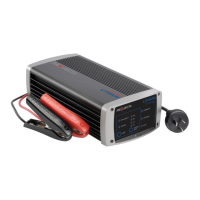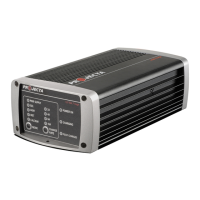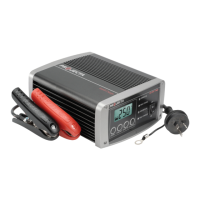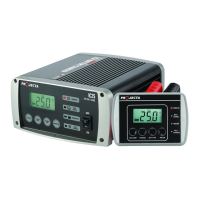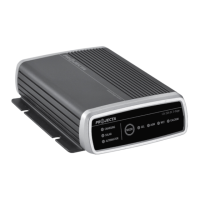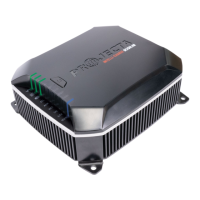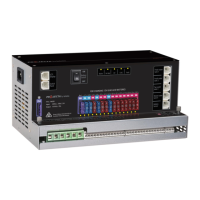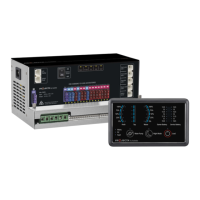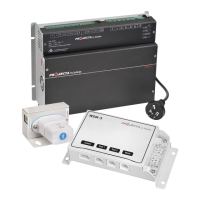Do you have a question about the Projecta IC1500 and is the answer not in the manual?
Key safety precautions and potential hazards associated with operating the battery charger.
Details the 7-stage charging process for optimal battery performance and extended lifespan.
Stage designed to break down sulphation in flat batteries, restoring charge.
Preliminary charge process to gently introduce power, protecting the battery.
Charges battery at maximum rate to a set voltage until approximately 80% charged.
Charges battery to 100% by adjusting charge rate to allow more power absorption.
Restores calcium batteries to full service by removing electrolyte stratification.
Tests battery to ensure it has taken charge, proceeding to float or recondition.
Automatically initiated if battery cannot hold charge after charging, attempts to restore it.
Maintains battery at 100% charge without overcharging or damage.
Charger's output can be adjusted to suit battery size for optimum charging.
Allows setting charging profile for GEL, AGM, WET, and Calcium batteries.
Allows safe running of appliances or loads from the battery.
Provides easy connection to hard-to-reach batteries, includes inline fuse.
Provides added durability and protection for specific models.
Prevents sparking from reverse connection or short circuit for safer operation.
Cools charger with fan or reduces power output if temperature rises too high.
Uses electronic components to convert 240VAC to 12VDC, making it lightweight.
Thermostatically controlled fan cools electronics and maintains charging performance.
Allows control and monitoring of charger performance from a remote display.
Details charge control parameters for Desulphation, Soft Start, Bulk, Absorption, Equalization, Analysis, and Float stages.
Specifies the set voltage and maximum current for power supply mode.
Lists recommended battery ranges (Ah, CCA, MCA) for Deep Cycle, Automotive, and Marine batteries.
Specifies compatibility with GEL, AGM, WET CELL, and CALCIUM lead-acid batteries.
Provides physical dimensions for IC700, IC700W, IC1000, and IC1500 models.
Lists the weight for different charger models.
Procedure for checking and topping up battery electrolyte levels before charging.
Instructions for connecting the charger to a battery when it is removed from the vehicle.
Steps for connecting the charger to a battery within a negatively earthed vehicle.
Instructions for connecting the charger to a battery within a positively earthed vehicle.
Procedure for connecting the charger using the vehicle harness for IC700 models.
How to connect the battery charger to the mains power supply.
Guide on setting the appropriate charge rate based on battery size.
Table showing recommended current settings for 12V batteries based on AH, CCA, and MCA ratings.
Instructions for selecting the correct battery chemistry type (GEL, AGM, WET, Calcium).
Explanation of charging process, LED indicators, and float stage.
Procedure for safely disconnecting the charger from the battery and mains power.
Check electrolyte level and top up if required, specifically for Calcium mode.
Instructions for hard-wiring the DC charging leads to the battery for permanent installations.
Explains the power supply mode, providing a constant 13.8VDC for running appliances.
Charge mode for GEL batteries with a maximum voltage of 14.1V.
Charge mode for AGM batteries with a maximum voltage of 14.4V.
Charge mode for WET batteries with specific voltages for different stages.
Mode for Calcium batteries, including equalization, for deep discharge restoration.
Procedure to lock/unlock charger settings to prevent accidental changes.
Details error codes displayed by LEDs and their corresponding remedies.
Indicates how to determine if the battery is fully charged using LEDs or a hydrometer.
Troubleshooting guide for when the charging LED does not illuminate.
Confirms the ability to use the charger as a power supply for appliances.
Explains charger reset behavior when the load exceeds its capacity in Power Supply mode.
Guide to interpreting LED indicators to identify the current charging stage.
Procedure to bypass Desulphation/Soft Start and initiate bulk charging using Power Supply mode.
Discusses the impact of connected appliances on charging accuracy and recommends Power Supply mode.
Explains when it's permissible to select a different battery chemistry based on voltage matching.
Explains the 'Equalization' stage in Calcium mode, which requires longer charging times.
Details the specific charging algorithm required for Calcium batteries due to their chemistry.
Defines Calcium batteries and lists benefits like lower internal resistance and higher temp tolerance.
Highlights consumer rights and guarantees under Australian Consumer Law.
Key safety precautions and potential hazards associated with operating the battery charger.
Details the 7-stage charging process for optimal battery performance and extended lifespan.
Stage designed to break down sulphation in flat batteries, restoring charge.
Preliminary charge process to gently introduce power, protecting the battery.
Charges battery at maximum rate to a set voltage until approximately 80% charged.
Charges battery to 100% by adjusting charge rate to allow more power absorption.
Restores calcium batteries to full service by removing electrolyte stratification.
Tests battery to ensure it has taken charge, proceeding to float or recondition.
Automatically initiated if battery cannot hold charge after charging, attempts to restore it.
Maintains battery at 100% charge without overcharging or damage.
Charger's output can be adjusted to suit battery size for optimum charging.
Allows setting charging profile for GEL, AGM, WET, and Calcium batteries.
Allows safe running of appliances or loads from the battery.
Provides easy connection to hard-to-reach batteries, includes inline fuse.
Provides added durability and protection for specific models.
Prevents sparking from reverse connection or short circuit for safer operation.
Cools charger with fan or reduces power output if temperature rises too high.
Uses electronic components to convert 240VAC to 12VDC, making it lightweight.
Thermostatically controlled fan cools electronics and maintains charging performance.
Allows control and monitoring of charger performance from a remote display.
Details charge control parameters for Desulphation, Soft Start, Bulk, Absorption, Equalization, Analysis, and Float stages.
Specifies the set voltage and maximum current for power supply mode.
Lists recommended battery ranges (Ah, CCA, MCA) for Deep Cycle, Automotive, and Marine batteries.
Specifies compatibility with GEL, AGM, WET CELL, and CALCIUM lead-acid batteries.
Provides physical dimensions for IC700, IC700W, IC1000, and IC1500 models.
Lists the weight for different charger models.
Procedure for checking and topping up battery electrolyte levels before charging.
Instructions for connecting the charger to a battery when it is removed from the vehicle.
Steps for connecting the charger to a battery within a negatively earthed vehicle.
Instructions for connecting the charger to a battery within a positively earthed vehicle.
Procedure for connecting the charger using the vehicle harness for IC700 models.
How to connect the battery charger to the mains power supply.
Guide on setting the appropriate charge rate based on battery size.
Table showing recommended current settings for 12V batteries based on AH, CCA, and MCA ratings.
Instructions for selecting the correct battery chemistry type (GEL, AGM, WET, Calcium).
Explanation of charging process, LED indicators, and float stage.
Procedure for safely disconnecting the charger from the battery and mains power.
Check electrolyte level and top up if required, specifically for Calcium mode.
Instructions for hard-wiring the DC charging leads to the battery for permanent installations.
Explains the power supply mode, providing a constant 13.8VDC for running appliances.
Charge mode for GEL batteries with a maximum voltage of 14.1V.
Charge mode for AGM batteries with a maximum voltage of 14.4V.
Charge mode for WET batteries with specific voltages for different stages.
Mode for Calcium batteries, including equalization, for deep discharge restoration.
Procedure to lock/unlock charger settings to prevent accidental changes.
Details error codes displayed by LEDs and their corresponding remedies.
Indicates how to determine if the battery is fully charged using LEDs or a hydrometer.
Troubleshooting guide for when the charging LED does not illuminate.
Confirms the ability to use the charger as a power supply for appliances.
Explains charger reset behavior when the load exceeds its capacity in Power Supply mode.
Guide to interpreting LED indicators to identify the current charging stage.
Procedure to bypass Desulphation/Soft Start and initiate bulk charging using Power Supply mode.
Discusses the impact of connected appliances on charging accuracy and recommends Power Supply mode.
Explains when it's permissible to select a different battery chemistry based on voltage matching.
Explains the 'Equalization' stage in Calcium mode, which requires longer charging times.
Details the specific charging algorithm required for Calcium batteries due to their chemistry.
Defines Calcium batteries and lists benefits like lower internal resistance and higher temp tolerance.
Highlights consumer rights and guarantees under Australian Consumer Law.
| Brand | Projecta |
|---|---|
| Model | IC1500 |
| Category | Battery Charger |
| Language | English |
